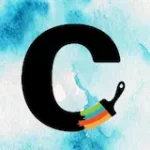So, what exactly is a freelance fashion designer? Think of them as creative partners for hire, bringing their design, technical, and conceptual magic to brands on a project-by-project basis. They're the pros who can take a spark of an idea and turn it into a garment—or an entire collection—that's ready for the market.
Laying the Groundwork Before You Hire
Before you even think about looking at portfolios, the most important work has to happen in-house. Trust me on this. Diving into the hiring process without a solid plan is like trying to build a house without a blueprint. It's a recipe for wasted time, money, and a whole lot of creative frustration. A clear, well-thought-out project brief is the absolute foundation of a successful partnership.
This prep phase isn't just about filling out a form. It's about translating your brand's DNA into a tangible vision for your collection. You're moving beyond vague ideas like "a new summer line" and getting into the specific, actionable details. A killer brief doesn't just guide the project; it also attracts top-tier talent by showing them you’re a serious brand that knows what it’s doing.
Define Your Deliverables and Vision
First things first: you need to get crystal clear on exactly what you need the designer to create. Vague requests are the root of all evil in this process, leading to mismatched expectations and endless revisions. Instead, create a detailed list of deliverables.
Your list might look something like this:
- Mood Board and Concept Development: This is the visual soul of the collection, capturing the aesthetic, tone, and target customer.
- Technical Sketches (Flats): These aren't just doodles. They're detailed, 2D drawings that map out every single seam, stitch, and piece of hardware.
- Complete Tech Packs: This is the manufacturing bible for each garment. It includes everything from measurements and materials to trim details and construction notes.
- Fabric and Trim Sourcing: A list of potential suppliers or the specific materials you need to bring the designs to life.
"A detailed brief ensures that a designer's creative interpretation aligns with your commercial goals. It's the most effective tool for preventing costly revisions and misunderstandings down the line."
This prep work is a linear process. You start with the big-picture vision, translate that into a concrete brief, and then attach a realistic budget to it.
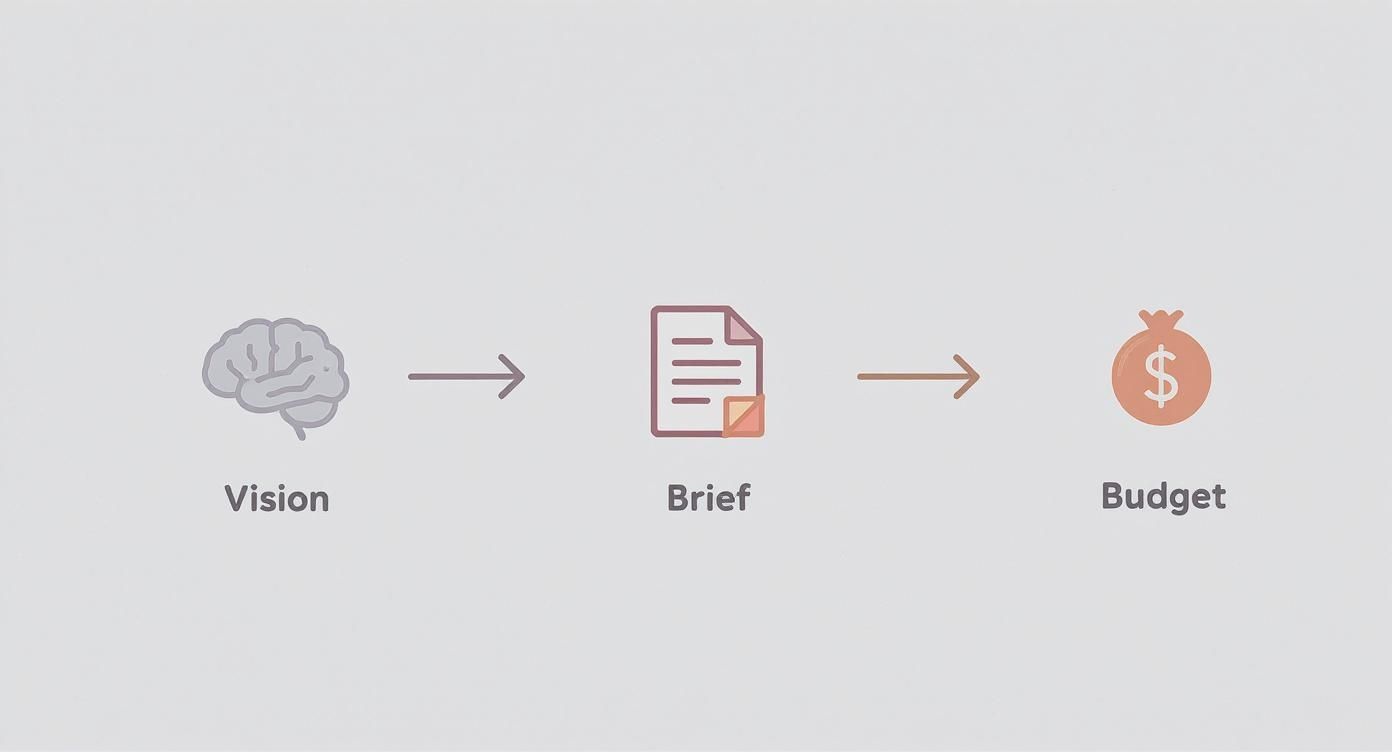
As you can see, each step logically builds on the last, creating a solid foundation for the entire project.
Set a Realistic Budget and Timeline
Finally, let's talk money and time. You need a realistic budget and timeline that will attract serious professionals, not just beginners. Do some research on industry rates. Experienced freelance fashion designers command higher fees for a reason—they bring efficiency, industry connections, and deep production expertise to the table. Your budget needs to reflect the scope of the work and the level of experience you’re after.
The same goes for your timeline. Great design doesn't happen overnight. Rushing the process almost always leads to compromised quality. A clear schedule with milestones for things like concept review, sketch delivery, and tech pack finalization shows designers that you respect their process and are organized enough to work with.
Putting this all into a single, clear document is key. For a bit more guidance, check out this helpful creative brief template to make sure you've covered all your bases. Getting this strategic foundation right from the start ensures that talented designers will instantly get what you’re trying to achieve.
Where to Find Top Fashion Design Talent
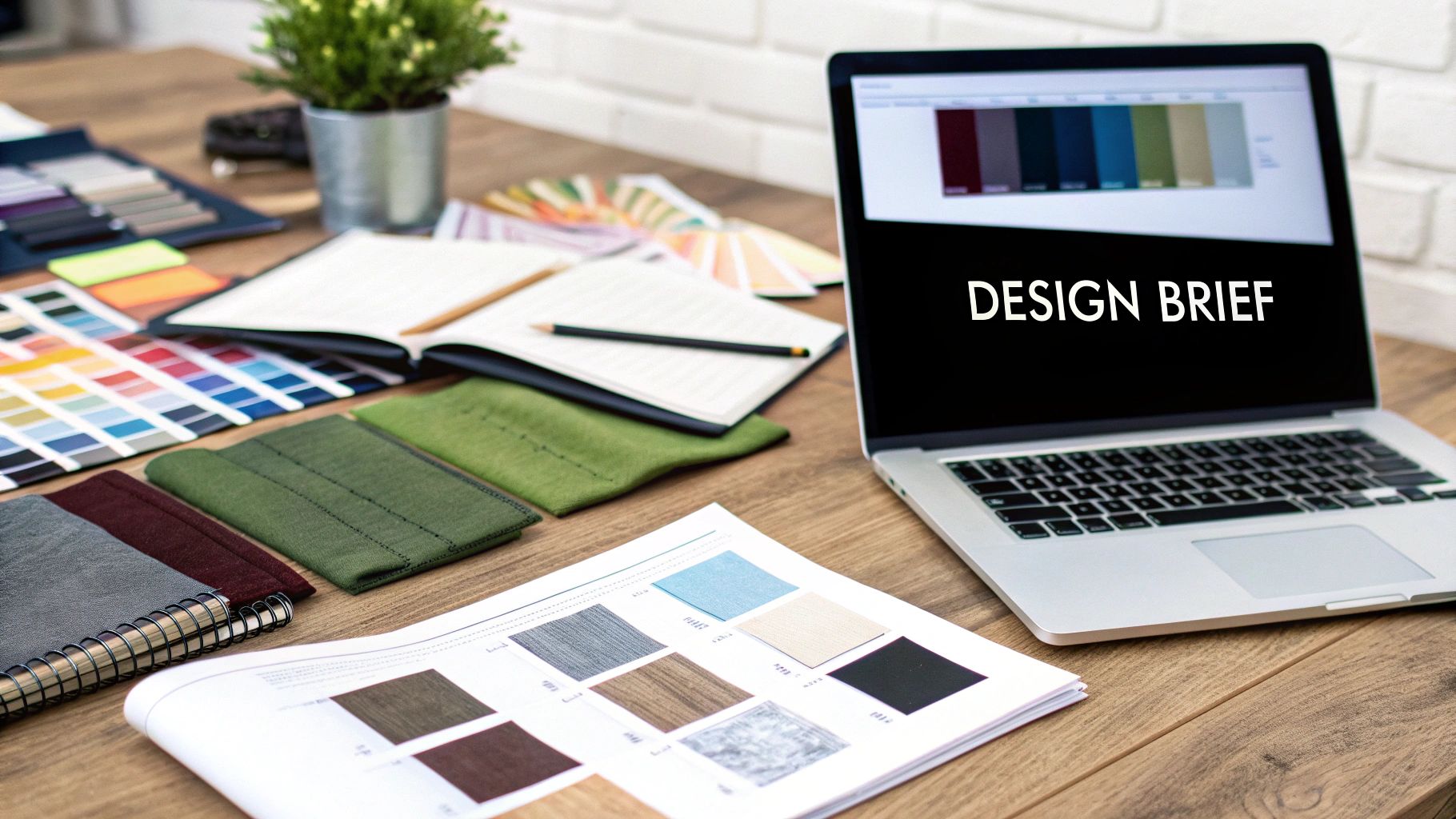
Alright, you’ve got a solid brief in your back pocket. Now for the exciting part: finding the creative partner who can take that vision and run with it. Forget aimlessly scrolling through generic job boards; the best freelance fashion designers hang out in specific digital spaces where their work really gets to shine.
Your first stop should be the portfolio platforms. Think of these as the digital showrooms where designers put their best foot forward, giving you an instant feel for their style and technical chops.
- Behance: This is a powerhouse for all things creative, and its fashion community is massive. You can get super specific by filtering for "apparel," "textile design," or even "fashion styling" to zero in on exactly who you need.
- Dribbble: While it’s better known for graphic design, Dribbble is becoming a hotbed for fashion illustrators and designers who have a modern, digital-first mindset.
These sites are fantastic for discovering raw talent and getting inspired, but they're just one piece of the hiring puzzle.
Niche Marketplaces and Professional Networks
To dig a bit deeper, you'll want to explore the fashion-specific marketplaces and professional networks. Platforms like The Dots or Style Lancer are built for the creative and fashion industries, which means the quality of talent is often a cut above the rest.
Then there’s LinkedIn. It’s an invaluable tool, but you have to use it differently. On LinkedIn, you get the full picture of a designer’s career—their education, past brand experience, and who’s willing to vouch for them. It's the perfect place to hunt for a specialist with a proven track record, like someone who's spent the last five years working exclusively in sustainable children's wear.
As you start looking, it's smart to sharpen your freelance hiring strategy by comparing platforms like Upwork and Fiverr to see which model best fits your project.
Remember, the goal isn't just to find a designer; it's to find your designer. Get specific with your search terms. Instead of just "fashion designer," try "freelance technical outerwear designer" or "3D apparel artist" to cut through the noise.
The demand for these specialized skills is absolutely booming, especially with the global fashion market projected to hit $880.9 billion in 2025. With fashion e-commerce revenue already pushing past $1.25 trillion, skills like tech pack creation and 3D modeling are becoming non-negotiable.
While these platforms are tailored for fashion, a lot of the same rules apply when you're looking for any great creative. Check out our guide on the best websites for hiring freelance graphic designers—you'll find some great strategies you can easily adapt for your search. The better you get at building a targeted list of candidates, the smoother your collaboration will be.
How to Vet Designers and Read a Portfolio
A beautiful portfolio can trick you. I've seen it happen dozens of times. The real challenge is separating the artistic flair from the technical, production-ready skills that actually get a garment made. You have to look past the slick photos and analyze a portfolio for what really matters to your brand: commercial viability, manufacturing know-how, and a rock-solid understanding of garment construction.
It’s about finding a partner, not just a sketch artist—someone who can bridge the gap between a creative spark and a physical, sellable product.
The first step is a mental shift. Instead of just admiring the finished pieces, you need to hunt for evidence of the process. A truly strong portfolio from a freelance fashion designer won't just showcase a killer final photo; it will pull back the curtain to show you sketches, fabric swatches, and most importantly, detailed flat drawings. This is how you know you're dealing with a professional, not just someone with a good eye.
Looking Beyond the Mood Board
When a portfolio lands in your inbox, skip the mood boards for a minute and go straight for the technical documents. A pretty sketch is an idea, but a production-ready tech pack is a blueprint.
Look for concrete examples of these docs. A complete tech pack proves the designer speaks the language of factories and understands that in manufacturing, precision is everything.
Here’s your checklist:
- Detailed Technical Flats: These are the 2D drawings showing every single seam, stitch, and piece of hardware. Are they clean, precise, and professional? Or do they look rushed?
- Bill of Materials (BOM): This is the recipe. It should list every single component, from the main body fabric down to the thread and hangtag string. This shows a meticulous attention to detail.
- Graded Spec Sheets: This is the gold standard. It includes measurements for a full-size range, proving the designer can create patterns that fit actual human bodies, not just a single size 6 mannequin.
If a portfolio is missing these key elements, it’s a huge red flag. It tells me the designer is probably strong on concept but weak on execution—a recipe for massive production headaches down the line.
A great portfolio balances inspiration with instruction. As you're reviewing, it helps to see how other top-tier creatives structure their work. Check out these creative portfolio website examples to get a feel for what a truly well-organized, professional presentation looks like.
Key Designer Skills to Evaluate
Before you even get to an interview, a designer's portfolio should give you a clear picture of their core competencies. Here's a quick breakdown of what to look for and why each piece of the puzzle is so important.
| Skill Category | What to Look For in a Portfolio | Why It Matters |
|---|---|---|
| Creative Vision | Cohesive collections, strong mood boards, unique color palettes, and a clear brand or aesthetic point of view. | Shows they can think beyond a single item and create a collection that tells a story, which is crucial for brand identity. |
| Technical Drawing | Clean, precise technical flats (CADs) with clear callouts for stitching, seams, and construction details. | This is the universal language of factories. Inaccurate or sloppy flats lead directly to expensive sampling errors. |
| Garment Construction | Examples of complex designs, detailed spec sheets, and an understanding of how different fabrics drape and sew. | Proves they know how a 2D sketch becomes a 3D garment. Without this, your designs might look great on paper but be unwearable. |
| Material Knowledge | Fabric swatches, detailed Bill of Materials (BOMs), and notes on sourcing or fabric properties. | A designer who understands fabric limitations and possibilities can prevent costly mistakes and elevate the final product. |
| Production Readiness | Complete tech packs, graded size specs, and any mention of factory communication or sample fittings. | This is the most critical part. It shows they're not just an "ideas person" but a professional who can deliver a final product. |
Seeing these skills laid out in a portfolio gives you confidence that you're looking at a candidate who understands the full scope of the job, from initial concept to the factory floor.
Asking Insightful Interview Questions
Once a portfolio passes the sniff test, the interview is your chance to dig in. Forget generic questions like, "What's your creative process?" You need to uncover their problem-solving skills and practical knowledge.
A designer's ability to anticipate and solve production challenges is often more valuable than their ability to sketch. Ask questions that reveal how they think under pressure and collaborate with manufacturing partners.
Try framing questions around real-world challenges you've faced or could face:
- On Problem-Solving: "Tell me about a time a fabric you selected didn't behave as expected after the first sample came back. How did you fix it?"
- On Manufacturing: "Our factory says a particular seam on a design is too complex to produce at scale. What are your first three steps to address that?"
- On Supplier Communication: "How do you normally communicate your design specs to a factory to make sure there are as few errors as possible?"
Their answers will tell you everything you need to know about their real-world experience with the inevitable hurdles of fashion production. Assessing their knowledge should also include their ability to navigate the supply chain, which includes understanding things like a designer's guide to choosing a fabric manufacturer.
This framework moves you beyond just hiring a designer and toward finding a true strategic partner—one with both the vision and the technical chops your brand needs to win.
Crafting a Freelance Contract That Protects You
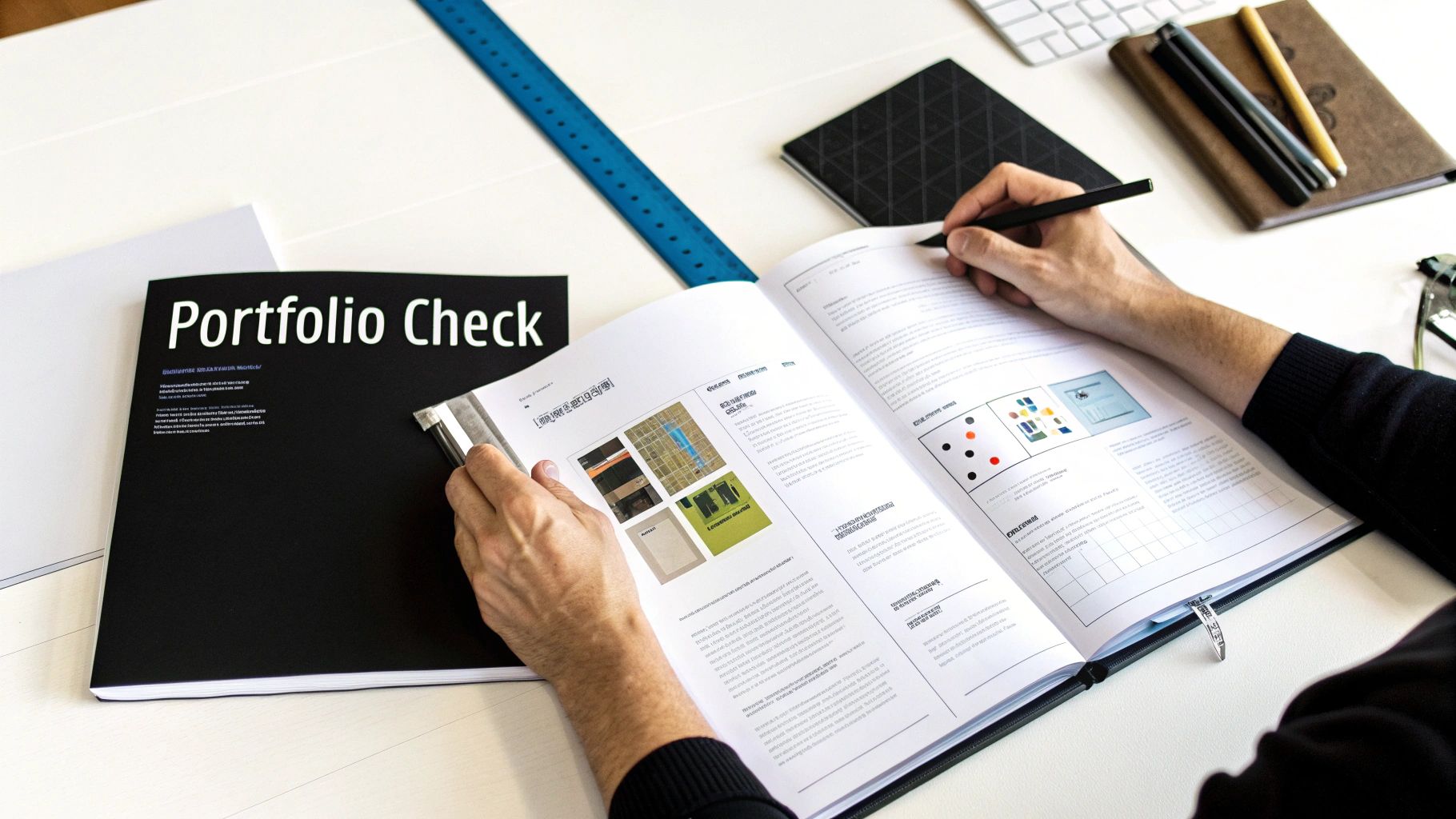
So, you've found the perfect designer. That's a huge step, but a handshake and a good vibe aren't enough to kick things off professionally. The single most important tool you have for a smooth collaboration is a solid, well-defined contract.
Don't think of it as a sign of mistrust. It's the exact opposite—it's about creating crystal-clear expectations for both of you. This document is the rulebook for your project, turning abstract conversations into concrete commitments and protecting your brand from expensive mix-ups later on.
Defining the Scope and Deliverables
The heart of any good contract is the Scope of Work (SOW). This is where you need to be ruthlessly specific, leaving zero room for interpretation. Using vague terms like "design a new collection" is just asking for trouble.
Instead, get granular. List every single thing you expect the designer to hand over.
- Three initial collection concepts, complete with mood boards.
- Ten complete tech packs for a women's knitwear line.
- Two rounds of revisions for each approved design.
This level of detail protects everyone involved. You know exactly what you’re paying for, and the designer understands the precise boundaries of the project. It’s the best way to shut down scope creep before it even starts.
Your contract should be a direct reflection of your project brief. If a deliverable isn't explicitly listed, don't assume it's included. Precision here prevents painful disagreements later.
Let's talk money. The financial side of hiring freelance fashion designers can be tricky. According to U.S. labor data, the median hourly rate for fashion designers hovers around $38.79, but seasoned freelancers often charge much higher project-based fees. They’re not just selling design skills; they're bringing sharp business acumen to the table. You can dig deeper into the employment landscape for fashion designers on bls.gov.
Intellectual Property and Ownership
Okay, lean in for this part—it’s the most critical clause in your entire agreement. Do not skim it.
By default, the law in many places says the creator (the designer) owns the rights to the work they produce. To protect your brand, you absolutely must include a work-for-hire clause.
This clause explicitly states that once the final payment is made, 100% of the intellectual property (IP), copyrights, and ownership of all designs transfer to your company. Without this, you could end up paying for incredible designs you don’t even legally own. That's a catastrophic mistake for any brand.
Your contract should also map out payment milestones tied directly to key deliverables. Something like this works well:
- 30% upfront to kick off the project.
- 40% when final tech packs are delivered.
- 30% after all final revisions are completed.
This structure keeps the project moving forward and ensures the designer is compensated fairly as they hit major milestones. To see how all these pieces fit together, check out our comprehensive guide and freelancer contract template—it’ll give you a solid foundation to build from.
Getting the Best Work From Your Designer
The contract’s signed, the first invoice is paid. Now for the fun part—and the part that makes or breaks the whole project. The way you manage this creative process will be the difference between a collection you can’t wait to launch and a frustrating, expensive mess.
Great collaborations don’t just happen. They’re built on purpose, with clear communication, mutual respect, and a laser-focused goal. This is a partnership, through and through. You hired a freelance fashion designer for their skills, but it's your job to steer their creativity so it lines up perfectly with your brand and your customers. Get that balance right, and the results will speak for themselves.
Find a Communication Rhythm That Works
Nothing kills a creative project faster than ambiguity. Sporadic emails and last-minute check-ins create chaos. Your first order of business should be to set a predictable, consistent rhythm for how you’ll talk.
Here’s a simple framework that gets the job done:
- Weekly Sync-Ups: Jump on a quick video call once a week. Use this time to see what’s been done, talk through any hurdles, and agree on what’s next. This keeps everyone on the same page and stops tiny issues from blowing up.
- Set Deadlines for Feedback: Agree on a simple schedule. Maybe the designer sends over sketches every Monday, and you promise to have consolidated feedback back to them by Wednesday. This creates a reliable workflow everyone can count on.
- Create a Central Hub: Don’t let important files get buried in email chains. Use a tool like Trello, Asana, or even a shared Google Drive folder to keep everything—files, feedback, reference images—in one place.
This isn’t about micromanaging. It's about building a professional structure that respects everyone’s time and keeps the project from getting bogged down.
Give Feedback That Actually Helps
Giving good feedback is an art. Vague notes like "I don't love it" or the classic "make it pop more" are a designer’s nightmare. They’re frustrating because they aren’t actionable. The goal is to be specific, constructive, and always, always tie your notes back to the original brief.
Your feedback should be a compass, not a critique. It’s your job to guide the designer back to the project’s true north: your target customer, your brand’s DNA, and your sales goals.
For example, instead of saying a design feels "too busy," try something like this: "Our customer really goes for that minimalist look we captured in the mood board. Let's try simplifying this piece by taking off the extra pocket details and using just one color for all the hardware." See the difference? Now the designer has a clear problem to solve, and it’s directly linked to the collection's strategy.
In a global fashion industry that now employs around 430 million people, this kind of clear, collaborative dynamic is essential. Top-tier freelance designers can turn around complex projects in just 13 to 24 days, and they thrive on sharp, focused direction. Get this partnership right, and you'll tap into that incredible speed in a market set to blow past $1 trillion by 2029. You can dive deeper into the global fashion industry's employment stats on bestcolorfulsocks.com.
When you build a relationship on trust and clear guidance, your designer stops being just a contractor. They become a genuine extension of your team, ready to deliver work that doesn’t just meet your expectations, but totally exceeds them.
Got Questions About Hiring a Freelance Designer? We’ve Got Answers.
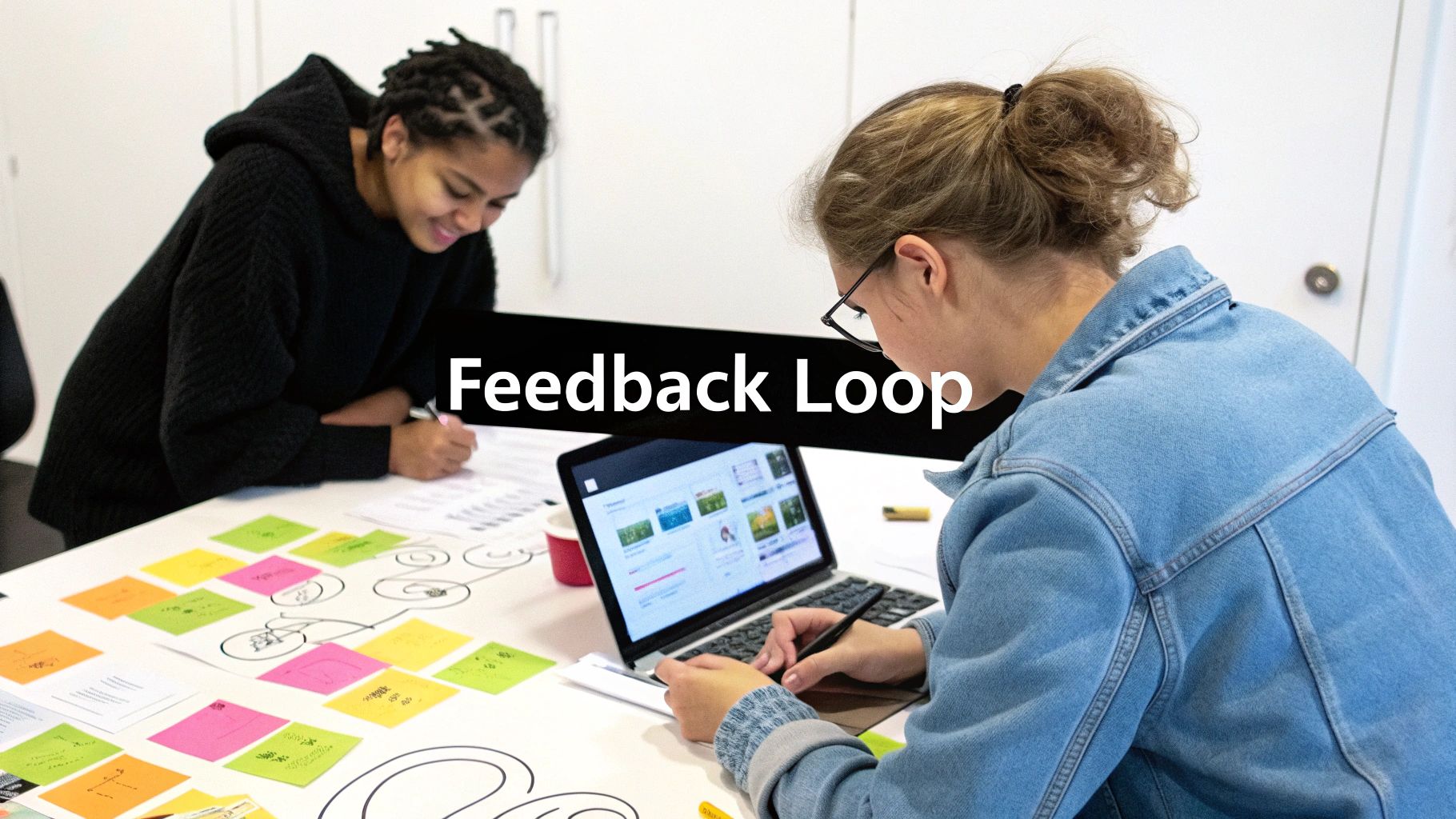
Diving into the world of freelance fashion designers for the first time? It's natural to have a few questions. Getting the practical stuff sorted out upfront is the key to a smooth partnership and avoiding those classic project-derailing headaches.
Think of this as your cheat sheet. We're cutting through the noise to give you direct, no-nonsense answers on everything from budgets to ownership. Let's get you prepped to make smart decisions from day one.
How Much Does It Cost to Hire a Freelance Fashion Designer?
This is the big one, and the honest-to-goodness answer is: it depends. There’s no simple price tag here. Costs swing wildly based on a designer’s experience, where they're based, and just how complex your project really is.
To put it in real terms, a basic t-shirt tech pack might run you somewhere between $150 and $300. But if you're commissioning a full five-piece capsule collection? That could be anywhere from $3,000 to over $15,000. It's a huge range.
Most experienced designers use a few common pricing models:
- Per-Project Fee: A flat rate for the whole shebang. Clean and simple.
- Hourly Rate: This can fall anywhere from $60 to $200 per hour, depending on their skill level.
- Monthly Retainer: Perfect if you need ongoing design support.
Your best move is to always ask for a detailed quote based on your specific brief. While we're talking fashion, many of the same pricing principles apply across creative fields. Our guide on freelance graphic design pricing has some great insights that are worth a read.
Who Owns the Intellectual Property of the Designs?
This is a deal-breaker. Make sure it's crystal clear in your contract from the get-go. For your brand's protection, you should always retain 100% of the intellectual property (IP) once the final invoice is paid. No exceptions.
So, how do you lock this down? Your contract needs a "work-for-hire" clause. This is the legal bit that officially transfers all ownership and rights of the final designs over to you. Without it, you could end up paying for beautiful designs you don't actually own.
What Should I Do If I Dislike the First Concepts?
First off, don't panic. This happens. It's a totally normal part of any creative process. Your first step is to pull up that contract and check how many rounds of revisions you both agreed to.
Now, it's all about giving good feedback. Instead of a vague "I don't like it," get specific. Refer back to your original brief and mood board. For example, try saying something like: "This feels a bit too formal for our relaxed brand vibe. Can we explore some of the more casual silhouettes we pulled in our reference images?"
Constructive, clear communication is everything. It turns a potential roadblock into a productive conversation.
At Creativize, we’re all about making it easier to find the right creative partner. Our platform is designed to connect you with incredible local talent ready to bring your vision to life. Discover the perfect designer for your next project on Creativize.

